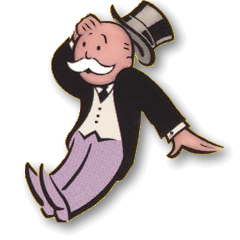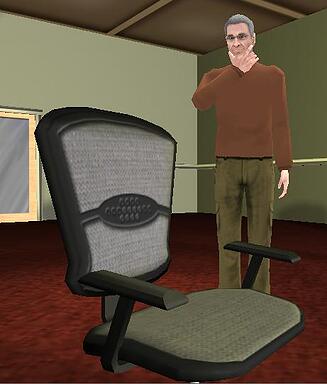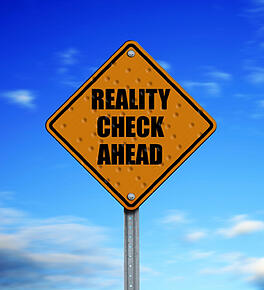 So what’s the goal of this story?
So what’s the goal of this story?Okay, so there’s a question you don’t often get when discussing novels or plays. What’s the goal? Well, the goal is to get to the last page of the book, or the curtain call at the end of the play. But when you’re writing stories for learning, the question takes on a different meaning. Not only are you telling a great story, you’re supposed to be helping your learner improve his or her performance.
Great learning stories include Goal-Based Scenarios. In simplest terms, the story includes a goal or a set of goals that need to be achieved; the point of going through the story is to achieve the goal. That sounds simple enough, but here’s the key: the nature of the goal impacts the way you perceive the story. Confused? Let’s break it down.
- First and foremost, the goal of learning is not just to make you smarter; the goal is to help you build the ability to do something. A Goal-Based Scenario begins to answer to eternal question of performance improvement: what am I going to be able to do as a result of this effort? Why is it important that I’m able to do this?
- In the business world, almost everything we do has a goal. Why should our business learning be any different? What kinds of problems can I solve with this knowledge?
- Ultimately, storytelling for learning works best when it presents real life conflicts. It can be pretty easy to regurgitate the “right” way to handle a problem, but can you really do it under pressure? You need to recreate that pressure for the learning to have emotional impact—and Goal-Based Scenarios do that. Rather than applying learning in a vacuum, you’re attempting to solve a real business problem—and actually having to apply what you’ve learned.
So how do you create a Goal-Based Scenario? In order to create good story-based learning, you need to be consultative. You need to understand the subtleties of the job and challenges your learners face in achieving success. For example, if I’m learning selling skills, my ultimate goal is probably to close a sale. But what are the subtleties of effectively closing? Is my customer more likely to buy if I take one path over another? Will I sell more if I’m able to meet my customer’s boss, who has more buying authority? Will I sell more long-term if I’m able to build a good relationship? Am I afraid to talk too much for fear my customer will realize I don’t know as much as I claim to know?
If you’d like to know more about Goal-Based Scenarios, here are a few references:
http://www.eduweb.com/goalbasedscenarios.html
http://www.edtech.vt.edu/edtech/id/models/gbs.html
http://www.engines4ed.org/hyperbook/nodes/NODE-227-pg.html


 o you want your learners to collaborate? To demonstrate leadership skills? To drive towards a goal? To evaluate and analyze situations before committing to a decision? To value the perspectives of others? To improve performance?
o you want your learners to collaborate? To demonstrate leadership skills? To drive towards a goal? To evaluate and analyze situations before committing to a decision? To value the perspectives of others? To improve performance? nesses about using games to improve performance way back in 1985. Back then, I was working mostly with mid-level and senior mangers, so talking about games required hushed tones and euphemisms. After all, busy important managers couldn’t spend time playing games. They had big, big decisions to make. And so what if the game was designed to help them be even more effective in making those big, big decisions? This was serious business. They weren’t games; they were “experiences,” or “competitions,” or “challenges.” Or maybe you just didn’t talk about it at all.
nesses about using games to improve performance way back in 1985. Back then, I was working mostly with mid-level and senior mangers, so talking about games required hushed tones and euphemisms. After all, busy important managers couldn’t spend time playing games. They had big, big decisions to make. And so what if the game was designed to help them be even more effective in making those big, big decisions? This was serious business. They weren’t games; they were “experiences,” or “competitions,” or “challenges.” Or maybe you just didn’t talk about it at all. A few months back,
A few months back, Reni: I read an article on The Economist titled:
Reni: I read an article on The Economist titled:  Rich: I attended several learning conferences this year, and at each one, I heard some variation on this message: it's time to get past old school training models, because the generation of 20-somethings entering the work force don't learn that way. We need social media for the 20-somethings, because that's how they learn. We need virtual environments for the 20-somethings, because that's how they learn. And every time, I wanted to scream from the back of the room, "HEY! I'M A 40-SOMETHING, AND I LEARN THAT WAY, TOO!"
Rich: I attended several learning conferences this year, and at each one, I heard some variation on this message: it's time to get past old school training models, because the generation of 20-somethings entering the work force don't learn that way. We need social media for the 20-somethings, because that's how they learn. We need virtual environments for the 20-somethings, because that's how they learn. And every time, I wanted to scream from the back of the room, "HEY! I'M A 40-SOMETHING, AND I LEARN THAT WAY, TOO!" Is there such a thing as too much reality?
Is there such a thing as too much reality? quently build interest by inserting compelling story twists. I won’t include any spoilers, but most people will admit to being thrown for a loop when they learned the truth about Bruce Willis’ character in
quently build interest by inserting compelling story twists. I won’t include any spoilers, but most people will admit to being thrown for a loop when they learned the truth about Bruce Willis’ character in  story takes a twist when it unexpectedly starts raining frogs. And perhaps that’s the key difference between movie storytelling and learning storytelling. If your story completely deviates from reality, you’ll probably lose your audience. So your story probably shouldn’t have any froggy precipitation.
story takes a twist when it unexpectedly starts raining frogs. And perhaps that’s the key difference between movie storytelling and learning storytelling. If your story completely deviates from reality, you’ll probably lose your audience. So your story probably shouldn’t have any froggy precipitation.

